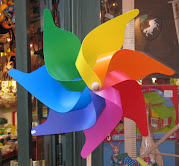I've just got back from a tour de force evening with Monique Bondolfi at our feminist theology group. In our series this year on "Dieu est belle" she gave us a superb overview of her conviction that God as Trinity is essentially God in relationship.
It would be impossible for me to sum up Monique's lucidity in a few lines here and I will post the whole of her paper to the fem theol blog in coming weeks. What excited me about tonight is how things fell into place for me - through small phrases like "God's strength is in God's weakness" or "God accepts otherness"; through Monique talking about the myth of order, unity and perfection as represented in the monotheism of the father figure; through her giving us copies of the journal she edits "Vivre au présent" which is all about networks. Suddenly I realised that this dancing, liberating, organised, spirit-filled, suffering, weak and powerful God was the one I believed in, a God who doesn't have all the answers but remains deeply in relationship and helps me and others through the non - sense.
As I was coming home I realised that this evening's study of the trinity also fitted in with the discussions several of us were having at lunch time about models of ecumenism for the 21st century. Do we want cathedral ecumenism (top down, institution driven) or bazaar ecumenism (networked, organic)? The idea for these two terms actually comes from software development.
So do you want a microsoft or a linux trinity, word or open office ecumenism? Let's open the theological software bazaar.
Tuesday, 10 March 2009
A dancing, liberating trinity with Monique Bondolfi at feminist theology and cathedral or bazaar ecumenism
Publié par Jane à l'adresse 22:21
Libellés : ecumenism, Feminist theology
Subscribe to:
Post Comments (Atom)






1 Comment:
This is the second time in as many months that I have encountered a great illustration of a theological / ecumnenical issue illuminated by a comparison to software. At a conference here in Manitoba Canada Doug Gay from the UK was trying to explain how he liked "high church" liturgical practice but couldn't buy the hierarchical forms of church government. He said he wanted to "unbundle" the software from the Operating System like the EU forced Microsoft to do. He wanted to use a "high church browser on his low church operating system". I hadn't heard the Cathedral and Bazaar image before but it reflects perfectly my emerging convictions about how ecumenism really works. I'm serving an established ecumenical shared ministry but our present reality is that people don't care about our denominational affiliations, its the job at hand that gets them excited. Thanks for some good insights I keep an ey on your comments through google reader.
http://pinawacf.blogspot.com/
Post a Comment